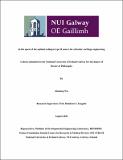In the quest of the optimal collagen type II source for articular cartilage engineering

View/
Date
2021-08-26Embargo Date
2025-06-30
Author
Wu, Zhuning
Metadata
Show full item recordUsage
This item's downloads: 0 (view details)
Abstract
Articular cartilage is a specialised connective tissue of joints, which lacks blood vessels, lymphatics and nerves. The limited capability of articular cartilage to self-repair renders its regeneration a formidable challenge. Collagen-based biomaterials are frequently used in cartilage engineering, however, most of them are focused on collagen type I scaffolds. In the quest of the ideal material for scaffold fabrication for cartilage engineering, the use of collagen type II has been advocated, as it is the major constituent of cartilage tissue. However, its optimal source still remains elusive.
In the first phase of this thesis, we ventured to assess the influence of biological sex (male, female) and tissue (articular, tracheal, auricular) on the biophysical, biochemical and biological properties of pepsin extracted porcine collagen type II sponges. Articular cartilage resulted in pure collagen type II preparations, whilst tracheal and auricular cartilage preparations were contaminated with collagen type I.
In the second phase of this thesis, the extensive use of antibiotics, religious tenets and the potential for interspecies disease transmission may restrict the use of mammalian derived collagens. In this regard, marine species derived collagen offers an opportunity as a safe, sustainable and environmentally friendly alternative to mammalian species derived collagen. Thus, herein it is hypothesised that there is an optimal chondrichthyan (cartilaginous fish) species [lesser spotted dogfish (Scyliorhinus canicula), thorn back ray (Raja clavata), cuckoo ray (Leucoraja naevus) and blonde ray (Raja brachyuran)] for pure collagen type II extraction and maximum chondrogenic induction of human adipose derived stem cells.
In the third phase of this thesis, bloom index and residual endotoxins in gelatin preparations were investigated, as they are crucial regulators of the product’s physicochemical and biological properties. Herein, gelatin preparations with variable bloom index and endotoxin level were used to fabricate crosslinked gelatin scaffolds, the physicochemical and biological properties of which were subsequently assessed.
Collections
Except where otherwise noted, this item's license is described as Attribution-NonCommercial-NoDerivs 3.0 Ireland
Related items
Showing items related by title, author, creator and subject.
-
Improving the sensitivity of radar-based breast imaging algorithms in diverse patient populations
O'Loughlin, Declan Denis (NUI Galway, 2018-09-03)Radar-based imaging is an emerging modality for breast cancer screening. Two commercial radar-based imaging devices are being tested in patient imaging studies. Promising initial results have highlighted the potential of ... -
Ontology learning for systems engineering body of knowledge
Yang, Lan (NUI Galway, 2020-09-14)Systems engineering (SE) is a multidisciplinary and integrative approach that enables the successful realization of engineered systems. It encompasses fundamentals, principles, and models of foundational systems science, ... -
Enhancing the situational awareness of the active distribution network
Khan, Maman Ahmad (NUI Galway, 2022-06-21)Power distribution system operation has become increasingly complex with the large-scale integration of Distributed Energy Resources (DERs). This has led to a paradigm shift in the operation and planning of the power ...

